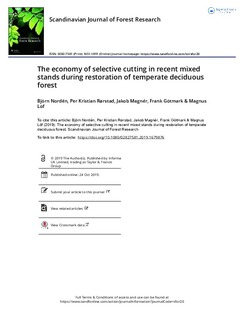| dc.contributor.author | Nordén, Björn | |
| dc.contributor.author | Rørstad, Per Kristian | |
| dc.contributor.author | Magnér, Jacob | |
| dc.contributor.author | Götmark, Frank | |
| dc.contributor.author | Löf, Magnus | |
| dc.coverage.spatial | Norway, Sweden | nb_NO |
| dc.date.accessioned | 2020-02-20T09:22:25Z | |
| dc.date.available | 2020-02-20T09:22:25Z | |
| dc.date.issued | 2019 | |
| dc.identifier.issn | 0282-7581 | |
| dc.identifier.uri | http://hdl.handle.net/11250/2642777 | |
| dc.description.abstract | Forest cover is increasing in many regions due to spontaneous reforestation on abandoned pastures and fields. The resulting recent forests may need management to improve ecosystem quality, and this could possibly be combined with timber production in specific cases. Temperate deciduous (TD) trees have declined steeply during the past millennium, but some now increase in the recent forests, often mixed with Norway spruce. Removing spruce may benefit these trees and for example oak regeneration, flowering plants and pollination. The total area of forest suitable for restoration in Norway and Sweden is >100,000 ha. We evaluate the cost of selective cutting based on 26 field trials, 13 in each country, and sales from the initial cutting on average just barely compensate for the costs. By resurveying plots from a parallel project in Sweden, we found that about half of the cut volume had regrown after 16 years, and a second thinning may be needed in the near future. Coarse woody debris (CWD) had increased by 78%, indicating increasingly natural conditions. We conclude that selective cutting in recent forests may be part of a strategy to reach restoration and sustainability goals, but that long-term incentives for landowners need to be developed. | nb_NO |
| dc.language.iso | eng | nb_NO |
| dc.rights | Attribution-NonCommercial-NoDerivatives 4.0 Internasjonal | * |
| dc.rights.uri | http://creativecommons.org/licenses/by-nc-nd/4.0/deed.no | * |
| dc.subject | Biodiversity | nb_NO |
| dc.subject | ecosystem services | nb_NO |
| dc.subject | pre-adaptive climate strategy | nb_NO |
| dc.subject | release treatment | nb_NO |
| dc.subject | semi-open canopy | nb_NO |
| dc.subject | broadleaf forest | nb_NO |
| dc.subject | woodland restoration | nb_NO |
| dc.title | The economy of selective cutting in recent mixed stands during restoration of temperate deciduous forest | nb_NO |
| dc.type | Peer reviewed | nb_NO |
| dc.type | Journal article | |
| dc.description.version | publishedVersion | nb_NO |
| dc.rights.holder | © 2019 The Author(s). | nb_NO |
| dc.subject.nsi | VDP::Matematikk og Naturvitenskap: 400::Zoologiske og botaniske fag: 480 | nb_NO |
| dc.source.pagenumber | 709-717 | nb_NO |
| dc.source.volume | 34 | nb_NO |
| dc.source.journal | Scandinavian Journal of Forest Research | nb_NO |
| dc.source.issue | 8 | nb_NO |
| dc.identifier.doi | 10.1080/02827581.2019.1679876 | |
| dc.identifier.cristin | 1740341 | |

